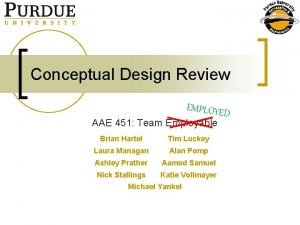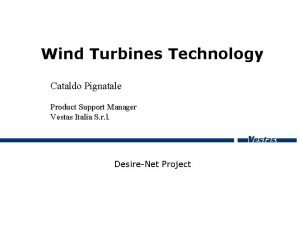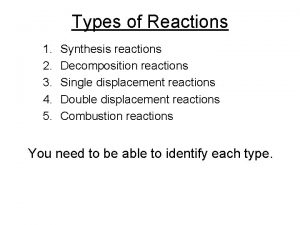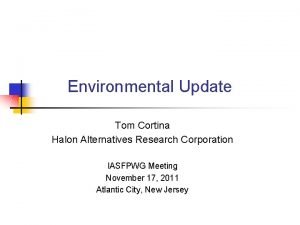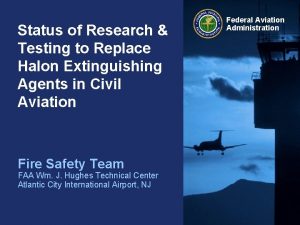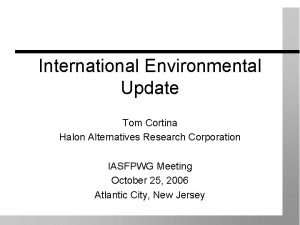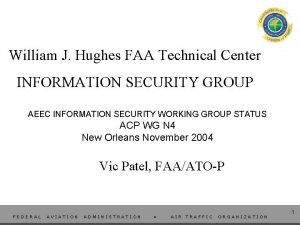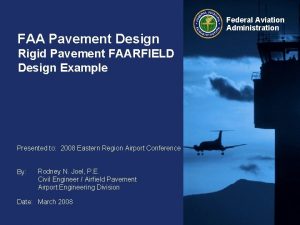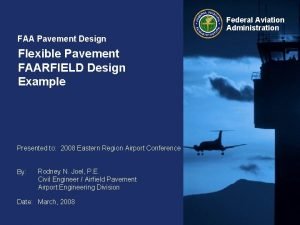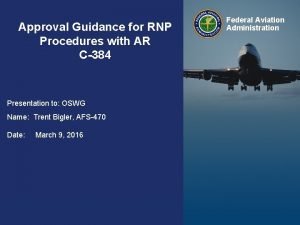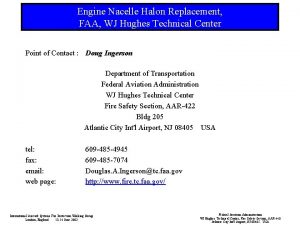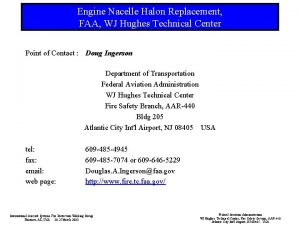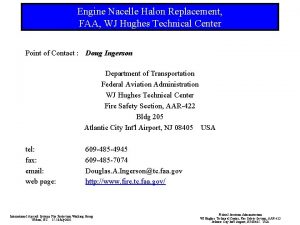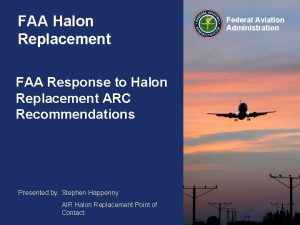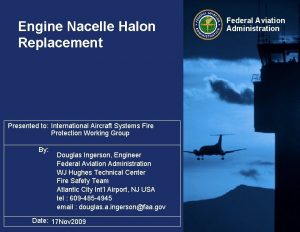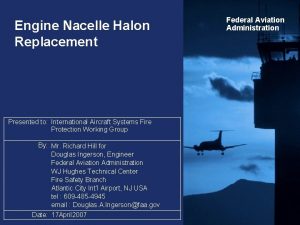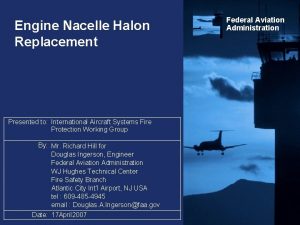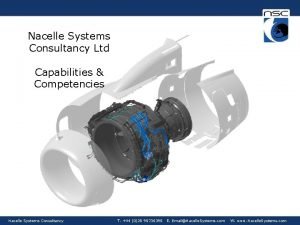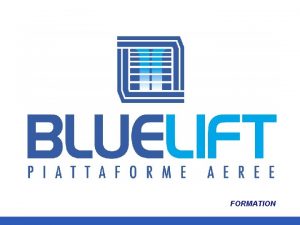Engine Nacelle Halon Replacement FAA WJ Hughes Technical













- Slides: 13

Engine Nacelle Halon Replacement, FAA, WJ Hughes Technical Center Point of Contact : Doug Ingerson Department of Transportation Federal Aviation Administration WJ Hughes Technical Center Fire Safety Section, AAR-422 Bldg 205 Atlantic City Int'l Airport, NJ 08405 USA tel: fax: email: web page: 609 -485 -4945 609 -485 -7074 Douglas. A. Ingerson@tc. faa. gov http: //www. fire. tc. faa. gov/ Systems Fire Protection Working Group Gatwick Airport South, United Kingdom 11 -12 Dec 2000 Douglas Ingerson, Federal Aviation Administration WJ Hughes Technical Center, Fire Safety Section, AAR-422 Atlantic City Int'l Airport, NJ 08405 USA

RESULTS FROM THE RECENT TASK GROUP MEETING OF AND NOTABLE EVENTS SINCE AUGUST 2000 >RESULTS FROM THE AUG 2000 TASK GROUP MEETING • Fire Suppression System Issues i Distribution plumbing inadequate for discharge durations less than 1 second i Firex servicing procedures require modification to improve distribution consistency • Test Section Issues i Lowest air mass flow capability requires determination i Maximum air temperature capability requires determination i Thermal control of the spray nozzle fuel line requires improvement i Hot plate temperature measurement requires improvement >NOTABLE EVENTS • Halonyzer II processor failed September 2000 Systems Fire Protection Working Group Gatwick Airport South, United Kingdom 11 -12 Dec 2000 Douglas Ingerson, Federal Aviation Administration WJ Hughes Technical Center, Fire Safety Section, AAR-422 Atlantic City Int'l Airport, NJ 08405 USA

PROGRESS/CURRENT STATUS >Fire Extinguisher Distribution Plumbing #the diameter of the agent flow path will be increased from the firex bottle to the first flow split #new 1 -1/4" ID ball valve due on-site 18 Dec 00 (delivery date has slipped twice) #other plumbing components on-site #modification can not be implemented until 1 -1/4” ball valve is in place >Firex Servicing #inconsistent equilibrium in the agent/N 2 mixture producing a noticeable variation in agent distribution profiles #procedure developed to minimize this problem >Halonyzer II Modification #processor demolished so specific components can be used in the new processor #new lap-top computer and A-D hardware to drive the transducers are on-site #software and transducer support in development #goal for operational capability is 1 st quarter, ‘ 01 Systems Fire Protection Working Group Gatwick Airport South, United Kingdom 11 -12 Dec 2000 Douglas Ingerson, Federal Aviation Administration WJ Hughes Technical Center, Fire Safety Section, AAR-422 Atlantic City Int'l Airport, NJ 08405 USA

Halonyzer II Processor Modification Remnants of the original processor to be incorporated into the modified processor Systems Fire Protection Working Group Gatwick Airport South, United Kingdom 11 -12 Dec 2000 Douglas Ingerson, Federal Aviation Administration WJ Hughes Technical Center, Fire Safety Section, AAR-422 Atlantic City Int'l Airport, NJ 08405 USA

PROGRESS/CURRENT STATUS (continued) >Low Mass Flow Capability #two tests run with more restricted inlet; mass flow in the 0. 7 -0. 8 lbm/s@72°F range is readily attainable #preliminary checks for stable flow appear consistent >Maximum Air Temperature Capability to Date (ambient inlet 75°F): #325°F@0. 2 lbm/s, 315°F@1. 4 lbm/s, & 275°@2. 3 lbm/s #expect changes in this capability; ambient inlet temperatures are in the 50°F range #will perform more characterization trials during December >Spray Nozzle Fuel Line Thermal Control #new water jacket currently being installed #will complete characterization in December >Hot Plate Temperature Measurement (four thermocouples per hot plate) #thermocouple reduced to 22 AWG from heavily armored units #bead is located under the head of tie-down screw for the exterior surface of the hot plate #temperature profiles increase noticeably; a 200°F (+) increase in temperature Systems Fire Protection Working Group Gatwick Airport South, United Kingdom 11 -12 Dec 2000 Douglas Ingerson, Federal Aviation Administration WJ Hughes Technical Center, Fire Safety Section, AAR-422 Atlantic City Int'l Airport, NJ 08405 USA

Lower flow capability based on more restrictive inlet Systems Fire Protection Working Group Gatwick Airport South, United Kingdom 11 -12 Dec 2000 Douglas Ingerson, Federal Aviation Administration WJ Hughes Technical Center, Fire Safety Section, AAR-422 Atlantic City Int'l Airport, NJ 08405 USA

Maximum Airflow Temperature Capability (ambient inlet 75°F) Systems Fire Protection Working Group Gatwick Airport South, United Kingdom 11 -12 Dec 2000 Douglas Ingerson, Federal Aviation Administration WJ Hughes Technical Center, Fire Safety Section, AAR-422 Atlantic City Int'l Airport, NJ 08405 USA

Water Jacket for the Spray Nozzle Fuel Line - Overview New water jacket for the spray nozzle fuel line Systems Fire Protection Working Group Gatwick Airport South, United Kingdom 11 -12 Dec 2000 Douglas Ingerson, Federal Aviation Administration WJ Hughes Technical Center, Fire Safety Section, AAR-422 Atlantic City Int'l Airport, NJ 08405 USA

Water Jacket for the Spray Nozzle Fuel Line - Test Section Penetration • Water jacket is a concentric shell and tube assembly • Entire assembly will initially be insulated Fuel line feeding spray nozzles • Water jacket to shield fuel line for 75% of its length in the test section • Completion and characterization expected during December Water jacket feed to test section interior Water jacket return to supply Systems Fire Protection Working Group Gatwick Airport South, United Kingdom 11 -12 Dec 2000 Douglas Ingerson, Federal Aviation Administration WJ Hughes Technical Center, Fire Safety Section, AAR-422 Atlantic City Int'l Airport, NJ 08405 USA

Comparison of Single Thermocouple Histories for the Same Physical Location on the Spray Hot Plate Surface Systems Fire Protection Working Group Gatwick Airport South, United Kingdom 11 -12 Dec 2000 Douglas Ingerson, Federal Aviation Administration WJ Hughes Technical Center, Fire Safety Section, AAR-422 Atlantic City Int'l Airport, NJ 08405 USA

DISCHARGE SIMULATION FOR THE NACELLE FIRE EXTINGUISHING SYSTEM Systems Fire Protection Working Group Gatwick Airport South, United Kingdom 11 -12 Dec 2000 Douglas Ingerson, Federal Aviation Administration WJ Hughes Technical Center, Fire Safety Section, AAR-422 Atlantic City Int'l Airport, NJ 08405 USA

DISCHARGE SIMULATION FOR THE NACELLE FIRE EXTINGUISHING SYSTEM “. . . EPA recognizes that when certain conditions exist, intentional releases of halon during testing will be necessary to verify system performance, which is essential to prevent loss of life and environmental damage. Therefore, today's action exempts from the ban on intentional releases, halon applications meeting the following four criteria: (1) Systems or equipment employing suitable alternative fire extinguishing agents are not available, (2) system or equipment testing requiring release of extinguishing agent is essential to demonstrate the functionality of the system, (3) failure of the system or equipment would pose great risk to human safety or the environment, and (4) a simulant agent cannot be used in place of the halon during system or equipment testing for technical reasons. Should conditions change such that an application currently meeting these criteria no longer met these criteria, then that application would no longer be exempt from the ban on intentional releases of halons during testing. ” Systems Fire Protection Working Group Gatwick Airport South, United Kingdom 11 -12 Dec 2000 Douglas Ingerson, Federal Aviation Administration WJ Hughes Technical Center, Fire Safety Section, AAR-422 Atlantic City Int'l Airport, NJ 08405 USA

DISCHARGE SIMULATION FOR THE NACELLE FIRE EXTINGUISHING SYSTEM >Guidance material is forth coming >The history and basis for this concept is provided in a published technical note. "Simulating the Distribution of Halon 1301 in an Aircraft Engine Nacelle with HFC-125, " DOT/FAA/AR-TN 99/64 >Once this guidance material is implemented, discharging Halon 1301 for the purpose of demonstrating acceptable compliance with FAA regulation will be illegal. This is based on compliance with the United States Environmental Protection Agency (EPA) regulatory activity. >EPA citation, “Halon Emissions Reduction” : • 63 FR 11084, Halon Emissions Reduction • dated 3 March 1998, effective 6 April 1998 • 40 CFR, § 82. 270 (b) Systems Fire Protection Working Group Gatwick Airport South, United Kingdom 11 -12 Dec 2000 Douglas Ingerson, Federal Aviation Administration WJ Hughes Technical Center, Fire Safety Section, AAR-422 Atlantic City Int'l Airport, NJ 08405 USA
 Nacelle chevrons
Nacelle chevrons Nacelle
Nacelle Combustion equation
Combustion equation Tom cortina
Tom cortina Haloni kao sredstvo za gasenje pozara
Haloni kao sredstvo za gasenje pozara Tom halon
Tom halon Xtase montreal
Xtase montreal Mark hughes jill hughes
Mark hughes jill hughes William j hughes technical center
William j hughes technical center William j hughes technical center
William j hughes technical center External vs internal combustion engine
External vs internal combustion engine Faa pavement design
Faa pavement design Faa pavement design software
Faa pavement design software C384 authorization
C384 authorization
